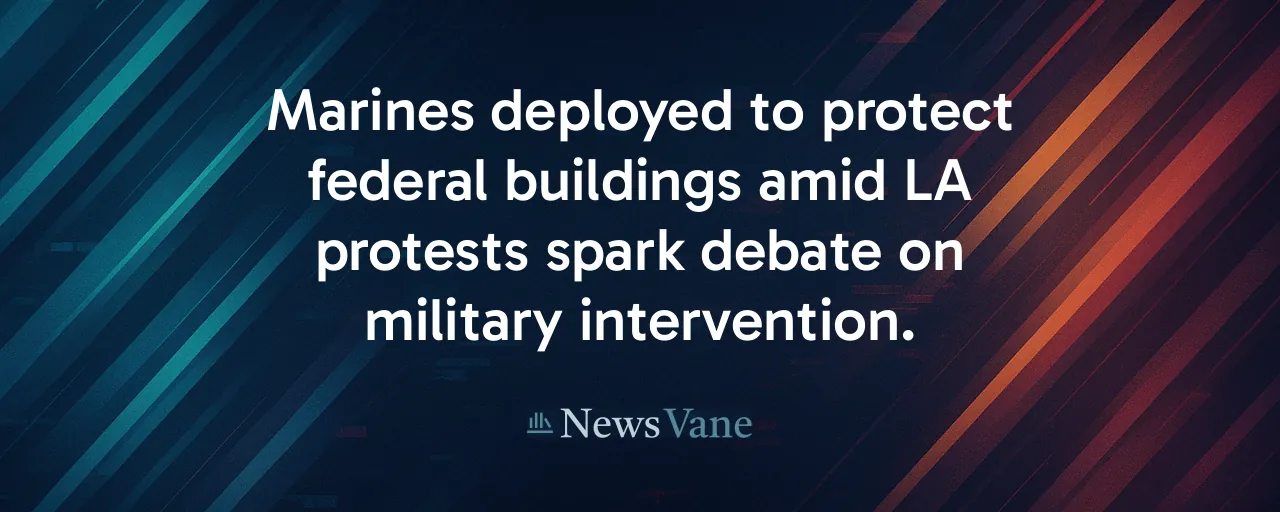Tensions Rise in Los Angeles
Los Angeles is unsettled. Protests, ignited by recent Immigration and Customs Enforcement raids, have led to vandalism and pockets of violence. Federal buildings, including the Wilshire Federal Building, now face graffiti and tightened security. On June 13, 200 Marines from the 2nd Battalion, 7th Marine Regiment arrived to protect these sites, taking over from California National Guard troops. Their arrival marks a rare federal intervention, prompting debate about when and how the military should act in domestic unrest.
President Trump ordered the deployment, which includes 4,700 personnel: 700 Marines and 4,000 federalized Guard members. The operation, managed by Task Force 51 under Army Maj. Gen. Scott Sherman, carries a $134 million price tag. Sherman stresses the troops' focus on safeguarding federal property and personnel, keeping them from engaging in law enforcement. Still, the presence of armed Marines in a major city unsettles many residents, who question the need for such a response.
This isn't a new scene for Los Angeles. The 1992 riots, sparked by the Rodney King verdict, saw Marines and Army units patrol the streets amid widespread chaos. Today's unrest, though significant, hasn't matched that intensity. So what drives this military response? A blend of legal authority, political decisions, and heightened concerns about protecting federal assets offers some answers.
The stakes feel high. Residents see federal buildings as both symbols and targets, while the government views their protection as non-negotiable. The Marines' arrival, though limited in scope, has turned a local protest into a national conversation about power, rights, and security.
Navigating Legal and Operational Lines
The deployment rests on the president's authority to protect federal property, using 10 U.S.C. §12406 to federalize the Guard and bypassing a formal Insurrection Act declaration. California Governor Gavin Newsom argues this oversteps federal bounds. A district judge briefly deemed the Guard mobilization unconstitutional, but the Ninth Circuit paused that ruling, allowing troops to stay as legal battles unfold over state and federal authority.
Operationally, the Marines have a narrow mission. Carrying helmets, shields, and batons, they secure perimeters around facilities like ICE and IRS offices. Sherman reports no detentions by troops, emphasizing their training in de-escalation and crowd control. Yet the image of combat-ready Marines in a civilian setting alarms civil liberties advocates, who worry about the impact on free expression and protest rights.
The financial cost adds another layer. At $134 million, the mission carries a significant price tag. The Pentagon has ensured troops have food, showers, and shelter, but those concerned about fiscal responsibility ask whether local police or state-led Guard units could have managed with less expense. The debate reflects broader tensions about federal resources and priorities in domestic crises.
Perspectives Clash
Advocates for decisive federal action defend the deployment as essential. They argue that unrest, like the 2020 protests that caused $2 billion in damages, can escalate quickly. Federal buildings, frequent protest targets, require strong defenses. Historical cases, such as President Eisenhower's 1957 deployment of troops to Little Rock, support the idea of federal action when local efforts fall short. The Marines, with their experience guarding embassies, are seen as well-suited for this task.
Those who prioritize civil liberties view the mission with concern. Civil liberties groups argue that active-duty troops in civilian spaces risk undermining democratic norms. The Posse Comitatus Act, which restricts federal troops from law enforcement, looms large in their critique, as they fear the mission edges too close to policing. Veterans' groups, like VoteVets, warn of strained morale and readiness. A 2020 poll highlighted a divide: 83% of Republicans supported military intervention in unrest, compared to 28% of Democrats.
Within the military, unease persists. A Naval War College survey revealed officers' reluctance to take on domestic policing roles, citing risks to public trust. Service members' social media posts reinforce this, expressing worry that such missions could weaken the military's 73% approval rating, as Gallup reported in 2019. The deployment, while legally sound, tests the fragile balance of civil-military relations.
What Lies Ahead
Los Angeles' unrest has brought the military's domestic role into sharp focus. Key questions linger: How much federal authority is appropriate in civilian crises? What are the costs, both in dollars and in public trust, of deploying troops to urban centers? Ongoing court cases may clarify legal limits, but shaping public opinion will take longer. History suggests approval for military action depends on whether it's seen as protecting order or curbing freedoms.
For now, the Marines hold their posts, their mission clear but their presence striking. The protests may fade, or they may intensify, demanding harder decisions. This moment highlights the challenge of balancing security with civil liberties, a tension that's surfaced before and will again.
Ultimately, Los Angeles residents, like all Americans, seek both safety and freedom. The path forward lies not in military might but in addressing the root causes of unrest. The Marines' role is temporary, but the work of building trust and stability belongs to the community.
